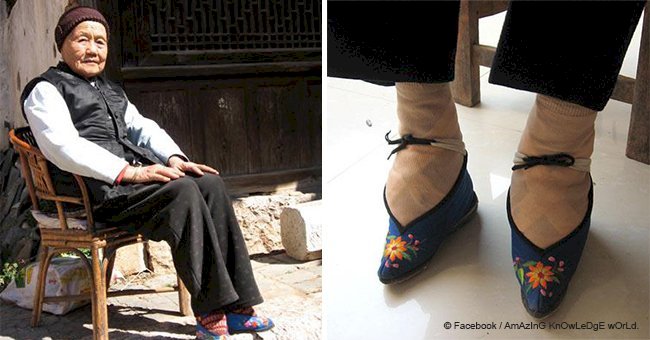
Woman, 86, who had to 'bind her feet' shows what this painful procedure looks like nowadays
One of the last Chinese women with bound feet gave an interview in 2007 to talk about what it was like to undergo the painful procedure and admitting she regrets having it done.
Then 86-year-old Zhou Guizhen was interviewed in 2007 by NPR, and a special about her was aired on March 19 on that year. Guizhen shared her painful memories of footbinding with the American news outlet.
At the time, Zhou was one of the last survivors of the curious practice, as some of her neighbors in the village of Liuyicun, in Southern China’s Yunnan province. Read more on our Twitter account @amomama_usa
According to NPR, by 2000, there were still 300 women with bound feet living in Liuyicun. Because the village was once very rich and bound feet were considered a sign of status, the practice was especially common over there.
A FORBIDDEN PRACTICE
Even though foot binding was outlawed in 1912, China’s rich families continued the practice for a long time in secret, and as unpleasant as it was, many women kept submitting to this cruel beauty standard as the only way to marry into money.
Zhou was among these women. She remembers having to trick government inspectors that visited home after home to prevent young women from having their feet bound.
"When people came to inspect our feet, my mother bandaged my feet, then put big shoes on them. When the inspectors came, we fooled them into thinking I had big feet," the octogenarian recalled.
A REGRETFUL DECISION
But time went by, and what once was seen as a mark of class and a cultural eccentricity, ended up seen as a form of female subjugation, and, in hindsight, Zhou completely agrees with that change of perspective.
"I regret binding my feet. I can't dance, I can't move properly. I regret it a lot. But at the time, if you didn't bind your feet, no one would marry you."
-Zhou Guizhen, NPR, March 19, 2007.
After the Communists confiscated all the possessions the rich family that Zhou married into thanks to her “golden lotus” feet, her sacrifice and that of many in her position proved to have been worthless.
REMNANTS FROM ANOTHER AGE
Yang Yang is an author who first became interested in foot binding because his mother Wang Lifen was a survivor of the practice, with her mother starting to bind her feet when she was only 7.
"These women were shunned by two eras. When they were young, foot binding was already forbidden, so they bound their feet in secret. When the Communist era came, production methods changed. They had to do farming work, and again they were shunned," Yang pointed out.
The writer sees his own mother, who after years of binding her feet married to a rich man she had never met and who turned out to be an opium addict, as a remnant from an age long gone.
WHY DID THEY START THIS PRACTICE IN THE FIRST PLACE?
For years, this practice, apparently originated between 961 and 975, when Li Yu, of the Song Dynasty, who ruled over parts of China, married with a dancer who bound her feet so they resembled a crescent moon.
Soon, people close to the court or with class aspirations started to adopt the practice as a new beauty standard until it gradually became nationwide.
Even though there were attempts to forbid it since as early as 1644, the practice remained popular, and many country girls used it as a way to climb the social ladder.
But as Post Magazine reported, the reasons why this practice was so much of the like of wealthy men looking for a wife might not be their looks, but something much more alluring to these men who saw women as their property and playthings.
According to the source, having such small feet required these women to walk in a certain way to not fall down, and this allegedly made the inner thigh and pelvic muscles become tighter than they normally are.
This characteristic apparently made having intercourse more pleasurable for their husbands.
Apart from male sexual satisfaction, having a wife with bound feet, which made them unable to work in the fields, showed that a man was in a financial position that allowed him to support an “unproductive woman.”
BODY MODIFICATION IN THE MODERN WESTERN WORLD
Although aesthetics and meanings have changed much over the years, and despite cultural differences between the West and the East, body modification is far from being just an outdated and exotic phenomenon.
Women have been known to go to great extents to change their bodies and overall appearance to meet the beauty standards of the time and place they were born into.
Still today, women undergo many procedures to chase an ideal of beauty pleasing to the “male gaze,” and this includes different kinds of prosthetics and other uncomfortable practices.
But body modification in a contemporary context sometimes also serves not to comply to society standards but precisely for the contrary, to make a statement about one’s individuality and defiance of the norm.
Take, for instance, the woman from New South Wales, Australia, who risked her eyesight by getting tattoos on her eyeballs to complete her desired look for her body in the last of many procedures that made her look like a reptile.
Or this Russian man who after having 90 percent of his body tattooed, had his genitals and nipples removed as he considered that these parts of his body were spoiling his entire aspect.
news.AmoMama.com does not support or promote any kind of violence, self-harm, or abusive behavior. We raise awareness about these issues to help potential victims seek professional counseling and prevent anyone from getting hurt. news.AmoMama.com speaks out against the above mentioned and news.AmoMama.com advocates for a healthy discussion about the instances of violence, abuse, sexual misconduct, animal cruelty, abuse etc. that benefits the victims. We also encourage everyone to report any crime incident they witness as soon as possible.
